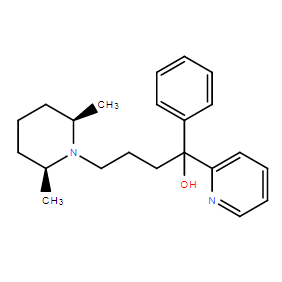| Cas No.: | 68252-19-7 |
| Chemical Name: | Pirmenol |
| Synonyms: | Pirmenol; Cl 845; Cl-845; Cl845; Pirmavar. |
| SMILES: | OC(C1=NC=CC=C1)(C2=CC=CC=C2)CCCN3[C@H](C)CCC[C@@H]3C |
| Formula: | C22H30N2O |
| M.Wt: | 338.5 |
| Purity: | >98% |
| Sotrage: | 2 years -20°C Powder, 2 weeks 4°C in DMSO, 6 months -80°C in DMSO |
| Description: | Pirmenol inhibits the carbachol-induced IK.ACh in a concentration-dependent manner. Pirmenol also inhibits the GTPγS-induced current although the concentrations of Pirmenol needed to inhibit the GTPγS-induced current are much higher than those to inhibit the carbachol-induced IK.ACh. The IC50 of Pirmenol for inhibition of the GTPγS-induced currents is 30 μM. The inhibitory effect of Pirmenol on these IK.ACh is almost completely reversible and the outward current reappeared upon washout of Pirmenol. Pirmenol on the muscarinic acetylcholine receptor-operated K+ current (IK.ACh) in atrial cells and on experimental atrial fibrillation in isolated guinea-pig hearts. In isolated atrial myocytes, Pirmenol concentration dependently inhibits the IK.ACh induced by carbachol or intracellular loading of GTPγS. In Langendorff-perfused hearts Pirmenol reverses the carbachol-induced decreases in effective refractory periods and atrial fibrillation threshold.The pyridine-methanol derivative Pirmenol is a new antiarrhythmic agent. Single-dose studies in rodents demonstrate a 10- to 15-fold difference between the po and iv LD50 values. In rats, the po LD50 is 359.9 mg/kg and the iv LD50 is 23.6 mg/kg. Mice LD50 values are 215.5 and 20.8 mg/kg for po and iv routes, respectively. Short-term subacute iv toxicity studies in rats (2.5, 5.0, and 7.5 mg/kg) and dogs (2.5, 5, and 10 mg/kg) for 4 weeks elicite minimal reactions. Cardiac effects in dogs include drug related increases in heart rate, increases QRS duration, shortening of ST interval without evidence of cardiac tissue damage and mild local reaction at the injection site. Orally, Pirmenol is well tolerated for 13 weeks in rats receiving 25, 50, and 100 mg/kg/day while dogs given 5, 10, and 15 mg/kg/day shows anticholinergic effects at high levels (dryness of mucosae, body tremors). Heart rates are significantly accelerated only at the beginning of the study and QRS changes are seen with wide individual variations. No drug-related tissue changes are elicited in these species. Teratology studies in rats (50, 100, and 150 mg/kg) and in rabbits (10, 25, and 50 mg/kg) show no overt effect on organogenesis but embryotoxicity is seen at 150 mg/kg in rats. |

 DC Chemicals' products qualify for U.S. tariff exemptions. We guarantee no price increases due to customs duties and maintain stable supply, continuing to deliver reliable research solutions to our American clients.
DC Chemicals' products qualify for U.S. tariff exemptions. We guarantee no price increases due to customs duties and maintain stable supply, continuing to deliver reliable research solutions to our American clients.





















